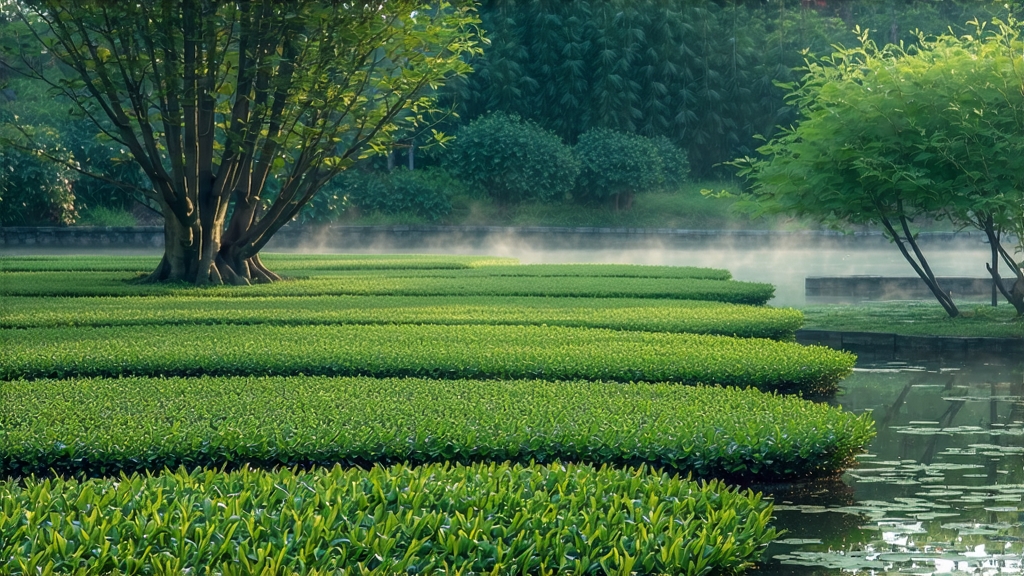
Longjing, literally “Dragon-Well,” is more than a tea; it is a liquid postcard from the hills that cradle Hangzhou’s West Lake, a sip that has greeted emperors, poets, and now the wider world. To understand why this single green tea commands reverence across China and curiosity abroad, one must follow its journey from myth-shrouded origins to the precise choreography of its brewing.
Historical whispers place Longjing’s birth in the Tang dynasty (618-907 CE), yet it was during the Song (960-1279) that the tea gained literary fame, and by the Qing (1644-1912) it had become the imperial tribute. Legend claims the Qianlong Emperor, while visiting the Hugong Temple beside Lion Peak Mountain, was so enchanted by the tea plucked from the 18 trees in front of the temple that he personally picked the leaves and tucked them into his sleeve, only to return later and bestow upon those bushes the honored title of “Imperial Tea Trees.” Whether apocryphal or not, the story cemented Longjing’s reputation as the green tea of emperors, a status still invoked today when sellers speak of “shi ba ke,” the eighteen trees whose descendants are auctioned for more than the price of gold per gram.
Geography is the first secret. The microclimate around West Lake—mist drifting off the water, moderate humidity, quartz-rich sandy loam, and a diurnal swing of 8-10 °C—slows leaf growth, concentrating amino acids and fragrant volatiles. Within the officially demarcated 168 km² core zone, five sub-areas are recognized: Lion (Shi), Dragon (Long), Cloud (Yun), Tiger (Hu), and Plum (Mei). Among them, Lion Peak Longjing remains the most coveted, its leaves flatter and more jade-colored, its infusion brighter and more orchid-sweet. Yet even within Lion Peak, elevation, slope aspect, and proximity to natural springs create micro-terroirs that connoisseurs debate with the fervor of Burgundy vintners.
Cultivar choice is the second secret. While the classic Longjing qunti zhong (heirloom shrub) still survives in scattered groves, most commercial leaf now comes from selected clones: Longjing #43, noted for early budding and high L-theanine; Zhongcha 108, prized for frost resistance; and the local Wuniuzao, whose leaves curve like sparrow tongues. Each clone responds differently to the same pan-firing hand, yielding cups that range from chestnut-sweet to bean-savory.
The plucking calendar is merciless. Pre-Qingming Longjing—picked before the 5th of April—represents barely 10 % of the annual harvest yet commands half the year’s revenue. A skilled picker can gather only 500 g of fresh leaf in a day, the equivalent of 100 g finished tea after moisture loss and firing. The standard is one bud plus the immediate unfolded leaf, 2.5 cm in length, snapped with a downward tug that avoids the woody stem. Anything longer or older is diverted to lower grades, sold as “second spring” or “spring rain” Longjing at a fraction of the price.
Within hours of picking, the leaf enters the workshop, where temperature, humidity, and the human hand perform a 250-year-old ballet called pan-firing (shaqing). Traditional craftsmen work on a cast-iron wok brushed with a whisper of West Lake water; the surface hovers at 80 °C for the first stage, killing green enzymes while locking in chlorophyll’s jade hue. Using only their bare palms—toughened by seasons of heat—they press, toss, and shake the leaf in rhythms that last 12–15 minutes. The second stage, called huiguo, lowers the temperature to 60 °C and shapes the leaf into the characteristic flat spear, 2 cm long and 0.5 cm wide, smooth enough to stand on edge when dropped into a glass. A master can judge readiness by ear: the rustle of leaves sliding across iron should sound like “silkworms devouring mulberry.” Over-firing by ten seconds turns the aroma from chestnut to burnt popcorn; under-firing by five invites grassy astringency.
Modern factories replicate the process with automated drums and infrared sensors, yet the highest grades still pass through human hands at least twice. The paradox is that mechanization improved consistency while